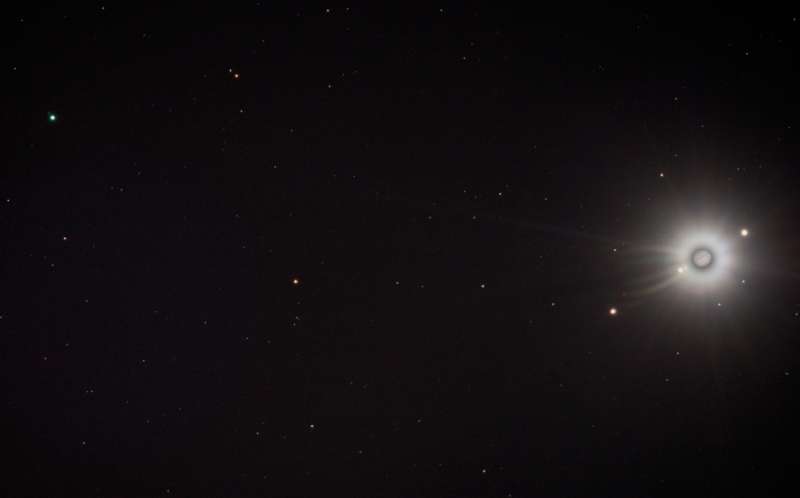Credit & Copyright: Peter Knappert
Explanation:
In late September, two planets were
opposite the Sun in Earth's
sky, Jupiter and Uranus.
Consequently closest to Earth,
at a distance of only 33 light-minutes
and 2.65 light-hours respectively,
both were good targets for telescopic observers.
Recorded on September 27, this well-planned composite of
consecutive multiple exposures captured both gas giants
in their remarkable celestial line-up accompanied by their brighter
moons.
The faint greenish disk of distant planet Uranus is near the upper
left corner.
Of the tilted planet's 5
larger moons, two
can be spotted
just above and left of the planet's disk.
Both discovered by 18th century British astronomer Sir William Herschel
and later named for characters in Shakespeare's
A Midsummer Night's Dream,
Oberon
is farthest left, with Titania
closer in.
At the right side of the frame is ruling gas giant Jupiter, flanked
along a line by all four of its
Galilean satellites.
Farthest from Jupiter is
Callisto, with
Europa and
Io all left of the planet's disk, while
Ganymede
stands alone at the right.
1999 2000 2001 2002 2003 2004 2005 2006 2007 2008 2009 2010 2011 2012 2013 2014 2015 2016 2017 2018 2019 2020 2021 2022 2023 2024 2025 |
Yanvar' Fevral' Mart Aprel' Mai Iyun' Iyul' Avgust Sentyabr' Oktyabr' Noyabr' Dekabr' |
NASA Web Site Statements, Warnings, and Disclaimers
NASA Official: Jay Norris. Specific rights apply.
A service of: LHEA at NASA / GSFC
& Michigan Tech. U.
|
Publikacii s klyuchevymi slovami:
Jupiter - Callisto - Europa - Ganymede - Io - Uranus - Oberon - titania - Yupiter - Ganimed - Evropa - Io - Kallisto - Uran - Titaniya
Publikacii so slovami: Jupiter - Callisto - Europa - Ganymede - Io - Uranus - Oberon - titania - Yupiter - Ganimed - Evropa - Io - Kallisto - Uran - Titaniya | |
Sm. takzhe:
Vse publikacii na tu zhe temu >> | |
